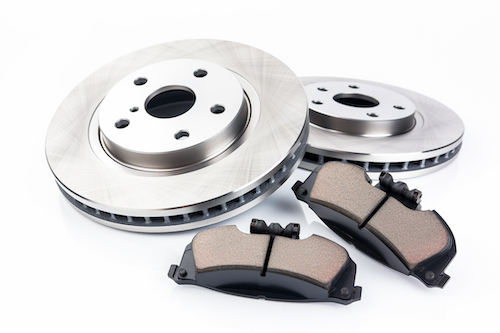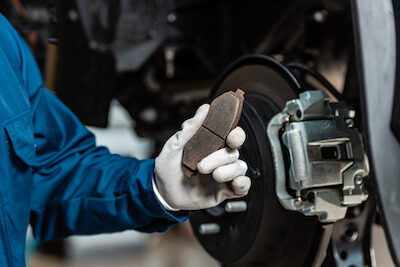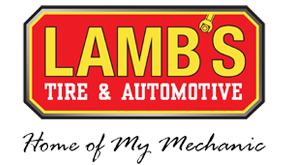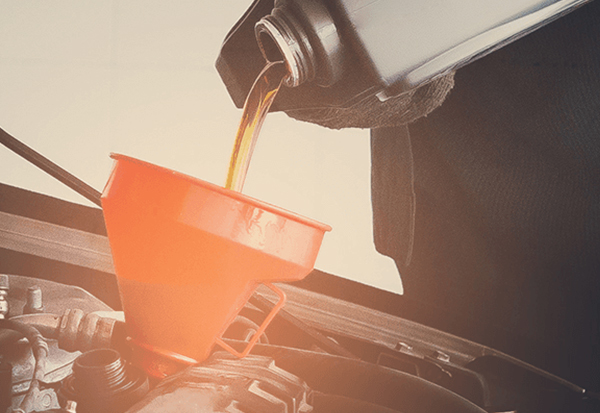Brake Pad Replacement: Guide to Types, Maintenance, and Replacement

Understanding how the different components of your vehicle work can be intimidating. Yet knowing the basics is critical for every driver. Among the most important components you should familiarize yourself with are brake pads. These components play a crucial role in ensuring that your vehicle effectively stops when you need it to.
In this guide, we break down everything you need to know about brake pads, including the different types available, how to know when it is time for brake pad replacement, brake pad longevity, and how to extend the life of your brake pads.
The Vital Role That Brake Pads Play in Vehicle Safety
When it comes to the safety of your vehicle, there are a few components as crucial as the brake pads. Think of them as the underrated heroes of your braking system, functioning as the front line of defense against accidents. These small but mighty parts are vital in ensuring that your brakes work effectively.
When you press the brake pedal, the brake pads exert pressure on the brake rotors, generating friction between the surface of the brake pads and the rotors. By creating friction, brake pads help convert the kinetic energy of your moving vehicle into heat energy, allowing it to come to a stop.
This frictional force is what gives you control and ensures that your car stops when needed.
Importance of High-Quality Brake Pads
Now that you understand the function of brake pads, it's crucial to recognize the significance of using high-quality ones. Investing in top-notch brake pads can make a significant difference in your vehicle's performance and safety on the road. High-quality pads offer:
- Enhanced stopping power: You’ll get superior performance, allowing you to stop your vehicle more efficiently. This increased stopping power can be particularly crucial in emergency situations where every second counts.
- Durability: Cheap or low-quality brake pads can wear down quickly, leading to decreased performance and potentially compromising your safety. Opting for high-quality brake pads ensures that they have the durability to withstand the demands of daily driving and provide consistent braking performance.
- Reduced noise and vibration: Inferior brake pads can generate annoying squealing or grinding noises when braking. High-quality brake pads are designed to minimize noise and vibration, providing a smoother and more comfortable driving experience.
- Longer lifespan: Investing in high-quality brake pads can save you money in the long run. While they may have a higher initial cost, their extended lifespan means you won't have to replace them as frequently, reducing maintenance expenses on brake pad replacement.
- Compatibility and performance: Manufacturers design high-quality brake pads to meet the specific requirements of your vehicle. This ensures optimal compatibility and performance, allowing your brakes to function at their best.
The Different Types of Brake Pads
Brake pads play a vital role in ensuring the performance and safety of your vehicle's braking system. Brake pads are an essential component of your car’s brakes that helps to stop your car efficiently and effectively. And when it comes time for brake pad replacement, understanding the different types is helpful to ensure that you get the right ones for your vehicle.
Three types of brake pads are available on the market today: semi-metallic, ceramic, and organic.
Semi-Metallic Brake Pads
As the most commonly used type, these brake pads are composed of a mix of metal fibers, such as steel or copper, combined with organic materials. These pads offer effective braking performance and are commonly used in a variety of vehicles, from sedans to pickup trucks.
The metallic content in these pads enhances their durability and heat dissipation capabilities, making them ideal for heavier vehicles or those driven in more demanding conditions. Semi-metallic brake pads provide excellent stopping power and are less prone to brake fade. However, they can be noisier than other types of pads and may produce more brake dust.
Ceramic Brake Pads
Ceramic brake pads are known for their superior performance and durability. They are made of a combination of ceramic fibers, non-ferrous fillers, and bonding materials. Due to their advanced composition, ceramic brake pads offer several advantages over the other types.
These pads provide excellent braking performance with reduced noise and minimal brake dust. They are also highly resistant to brake fade, making them an excellent choice for high-performance vehicles and heavy-duty applications. Another benefit of ceramic brake pads is their longer lifespan, which can result in cost savings over time. However, they tend to be more expensive than the other types of brake pads.
Organic Brake Pads
These brake pads, also known as non-asbestos organic brake pads, are made of a combination of organic fibers, such as rubber, glass, and Kevlar, mixed with a binding resin. Organic brake pads are often the most affordable option and provide a smooth and quiet braking experience.
One of the advantages of organic brake pads is their ability to offer consistent performance across a range of temperatures. They also tend to generate less brake dust, keeping your wheels cleaner. However, organic brake pads may wear out faster than other types and are not suitable for high-performance vehicles or heavy-duty applications.
Remember to check your vehicle manufacturer's recommendations and consider your driving habits and needs when selecting brake pads. (More on this below.) Regular maintenance and timely replacement of worn-out brake pads are essential to ensuring that your vehicle's braking system operates reliably.
When To Replace Brake Pads
As mentioned above, brake pads play a crucial role in ensuring effective braking performance by providing the necessary friction to bring your car to a safe stop. But, unfortunately, they don’t last forever. Over time, the friction material wears out and compromises your ability to stop safely.
You don’t want to wait until it’s too late to perform the necessary maintenance on your brake system. So knowing when to replace your brake pads is essential for maintaining optimal braking performance and preventing jeopardizing the safety of your vehicle.
The Recommended Mileage Interval
A general guideline is to have professional brake pad replacement done every 25,000 to 70,000 miles. However, it is always recommended to consult your vehicle's owner's manual for specific recommendations from the manufacturer.
It’s also important to note that your driving habits, road conditions, and the type of brake pads installed can all affect the exact mileage intervals. For example, if you frequently drive in stop-and-go traffic or navigate hilly terrains, you may need to replace your brake pads more frequently. Regular maintenance and inspections at a brake shop can help identify signs of wear and extend the lifespan of your brake pads.
Brake Pad Wear Indicators
Many modern brake pads are equipped with wear indicators, which are small metal clips or grooves designed to make contact with the rotor when the pads wear down to a certain level. When the wear indicators come into contact with the rotor, they produce a high-pitched squealing sound, alerting you that it's time to replace the brake pads.
If you hear a squealing or screeching noise when you apply the brakes, the wear indicators are likely making contact with the rotors. Ignoring this warning sign can lead to further damage and compromise your vehicle's braking performance. Therefore, it’s crucial to address this issue promptly and have your brake pads replaced.
Warning Signs That You May Be Overdue for Brake Pad Replacement
Loud noises coming from your brakes are one of the most common and most noticeable indicators that it’s probably time for brake pad replacement. But here are a couple of other warning signs you should also be aware of:
Vibration or Pulsation in the Brake Pedal
If you feel a vibration or pulsation in the brake pedal when pressing it, this could indicate that your brake pads are worn unevenly or have developed deposits on the surface. When this happens, the brake pads cannot provide a consistent grip on the rotor, leading to the pulsation sensation. If you experience this symptom, visit your local brake shop ASAP to have your brake pads inspected and replaced if necessary.
The Vehicle Is Pulling to One Side When Braking
When your brake pads wear unevenly, it can result in your vehicle noticeably pulling to one side when you apply the brakes. This can lead to a decrease in how well your vehicle handles. If you notice this happening, it's important to have the brakes checked by a professional brake shop in Austin as soon as possible.
Decreased Braking Performance
If you have noticed that your vehicle takes longer to come to a complete stop when pressing the brake pedal, your brake pads may be worn out. As the brake pads wear down, they gradually lose their ability to grip the brake rotor effectively, resulting in decreased braking performance. If you find yourself having to press the brake pedal harder or if your vehicle takes longer to stop, it's time to have your brake pads inspected.

By paying attention to these signs of worn-out brake pads, you can ensure that your vehicle remains safe on the road. Remember, it's always better to address brake pad issues early on to prevent further damage to your brake system.
Factors To Consider When Choosing Brake Pads
When it comes time for brake pad replacement, there are several important factors to consider when choosing new brake pads. The right ones can make a significant difference in your vehicle's performance and your overall driving experience. There are three key factors that you should keep in mind when selecting brake pads:
Vehicle Compatibility
The first factor to consider when choosing brake pads is their compatibility with your specific vehicle. Not all brake pads are designed to fit every make and model, so it's crucial to ensure that the pads you choose are specifically designed for your type of vehicle. This information can typically be found in the product description or on the manufacturer's website.
Using brake pads that are not compatible with your vehicle can have detrimental effects on your braking system, leading to reduced braking efficiency, increased stopping distances, and even potential damage to other components. So always double-check the compatibility before making a purchase.
Driving Style
Your driving style is another crucial consideration when selecting brake pads. Different brake pad materials offer varying levels of performance and durability, catering to different driving styles. If you have a more aggressive driving style or frequently engage in higher-speed driving, you may want to consider performance-oriented brake pads (namely semi-metallic pads).
On the other hand, if you primarily drive in stop-and-go traffic or have a more relaxed driving style, you might benefit from brake pads that prioritize durability and longevity over high-performance capabilities. Understanding your driving habits will help you choose the brake pads that best suit your needs.
Climate Conditions
Climate conditions can also play a significant role in determining the most suitable brake pads for your vehicle. If you live in a hot and dry climate, you might want to opt for brake pads that can withstand high temperatures without experiencing brake fade. Brake fade occurs when the braking system overheats, leading to reduced braking effectiveness.
Alternatively, if you live in an area with frequent rain, snow, or ice, you should consider brake pads that offer excellent wet-weather performance. These pads typically have enhanced friction materials that provide better stopping power in slippery conditions. Choosing brake pads designed to handle extreme temperatures will ensure optimal performance in your specific climate.
By taking these factors into account, you can choose brake pads that not only fit your vehicle but also provide the performance and durability you require for a safe and enjoyable driving experience.
Tips To Help Extend the Life of Your Brake Pads
To ensure that your brake pads last as long as possible and maintain optimal performance, it’s important to follow some essential maintenance tips. By implementing the following practices, you can extend the life of your brake pads and ensure the safety of your vehicle and passengers:
Regular Brake Pad Inspections
Regularly inspecting your brake pads is key to maximizing their lifespan. Visually check them through the wheel spokes for signs of wear, like thinning or unevenness. If they're less than 1/4-inch thick, they need to be replaced. Also, listen for odd, loud noises, like squealing or grinding, as these may mean worn-out brake pads.
Gentle Braking
Practicing gentle, controlled braking helps brake pads last longer. Sudden, harsh stopping adds significant excess stress on the pads. Instead, anticipate stops and gradually apply brakes for even force distribution. This reduces wear on pads and boosts fuel efficiency.
Avoid Excessive Weight
Removing excess weight from your vehicle eases the strain on brake pads. Take out unnecessary items from your trunk and backseat to lighten the load and extend brake pads’ lifespan.
Maintain a Safe Following Distance
Maintaining a safe following distance isn't just a safety measure — it also helps your brake pads last longer. You can avoid sudden and aggressive braking by staying a reasonable distance behind the car ahead. Again, this reduces excess wear on your brake pads.
Brake Fluid Checks
It's important to regularly check your brake fluid level when assessing the health of your braking system. Low fluid levels can harm pad performance and cause premature wear. Refer to your owner's manual for instructions on checking and topping off the brake fluid when needed.
Professional Brake Maintenance
Regular maintenance by a qualified Austin brake repair mechanic is crucial for keeping your brake pads in good shape. Inspections catch problems early and prevent more damage. Mechanics can also make necessary adjustments, like brake pad alignments, for even wear.
Remember, a well-maintained braking system not only contributes to the longevity of your brake pads but also provides you with peace of mind on the road.
Lamb’s Tire & Automotive Are the Local Experts in Austin Brake Repair
The brake pads are an essential part of keeping your vehicle's braking system safe and working optimally. With the information we’ve covered in this guide, you can confidently maintain your brake pads and have them replaced when needed. Doing so will allow you to drive with peace of mind while ensuring the safety of yourself and other drivers around you.
Now that you have a comprehensive understanding of brake pads, it's time to apply this knowledge and take the necessary steps to keep your vehicle's braking system in optimal condition.
Are you searching through options for professional brake shops that you can trust for reliable maintenance and repair service? If so, look no further than the expert team at Lamb’s Tire & Automotive. Our ASE-certified mechanics offer a full range of brake services to proudly meet the needs of local drivers looking for reliable Austin brake repair. From brake pad replacement to fluid flush, we’ve got you covered! By using high-quality parts and professional tools, we can help ensure that you always get top-notch performance and reliability for your vehicle's brakes.









